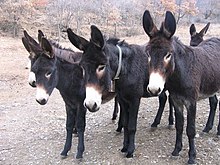Catalan donkey
| Other names |
|
|---|---|
| Country of origin | Spain, France |
| Distribution |
|
| Standard | MAPA (in Spanish) |
| Traits | |
| Weight |
|
| Height | |

The Catalan (Catalan: Ase Català or Ruc Català, Spanish: Asno Catalán) is a breed of large domestic donkey from the historic region of Catalonia, now in north-eastern Spain and south-western France. Approximately 80% of the breed population is in the modern autonomous community of Catalonia, and approximately 20% is in the historic Roussillon region of France.[5]
History
The Catalan breed is considered to be very old;[6] Pliny the Elder mentions donkeys on the Plain of Vic, in the comarca of Osona.[5][6] Some believe it to be related to the Mallorquín and the Zamorano-Leonés donkey.[7]
It originates in the basins of the
The Catalan has been exported to many countries, among them Algeria, Congo, Madagascar, Tunisia and Zaire in Africa; Argentina, Brazil, Canada, Cuba and the United States in the Americas; and also Australia, Germany, India and the United Kingdom.
Characteristics
The Catalan is a large donkey, and generally weighs between 350–450 kg.[4] Height at the withers is some 145–160 cm for jacks, about 10 cm less for jennies.[3]: 22
Use
The traditional use of the Catalan was as a sire for
References
- ISBN 9789251057629. Archived 23 June 2020.
- ^ a b Breed data sheet: Catalana / Spain (Ass). Domestic Animal Diversity Information System of the Food and Agriculture Organization of the United Nations. Accessed December 2020.
- ^ ISBN 9781780647944.
- ^ a b c Resolución ARP/680/2002, de 26 de marzo, por la que se reglamenta el Libro Genealógico de la raza asnal catalana (in Spanish). Ministerio de Agricultura, Alimentación y Medio Ambiente. Archived 4 March 2016.
- ^ a b c d Raza equino asnal Catalana: Datos generales (in Spanish). Ministerio de Agricultura, Alimentación y Medio Ambiente. Archived 19 May 2016.
- ^ a b c d e Jordi Jordana Vidal (updated 2018). Ase Català: Origen i Història (in Catalan). Universitat Autònoma de Barcelona: Facultat de Veterinària, Departament de Ciència Animal i dels Aliments. Archived 10 May 2021.
- ^ Ase català (in Catalan). Generalitat de Catalunya: Departament d'Agricultura, Ramaderia, Pesca, Alimentació i Medi Natural. Accessed July 2014.
- ^ Waltraud Kugler, Hans-Peter Grunenfelder, Elli Broxham (2008). Donkey Breeds in Europe: Inventory, Description, Need for Action, Conservation; Report 2007/2008. St. Gallen, Switzerland: Monitoring Institute for Rare Breeds and Seeds in Europe. Archived 2 September 2009.
- ^ . (subscription required).
- ^ ISBN 9788449109461.
- ^ [s.n.] (7 March 2012). Mor el 'pare' del ruc català (in Catalan). El Punt Avui. Archived 14 July 2014.
- ^ Raza equino asnal Catalana: Datos censales (in Spanish). Ministerio de Agricultura, Alimentación y Medio Ambiente. Accessed May 2014.
